
DJC.COM
October 2, 2003
Is Seattle ready to wear the Vancouver style?
Special to the Journal
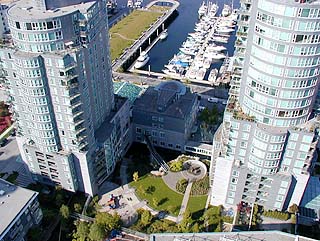
Photos by Gordon Price
Avila at Bauhinia, one of the first developments in Vancouver’s Coal Harbour neighborhood, was built in the late 1990s.
|
Could Vancouver be coming to a neighborhood near you?
In at least one West Coast city, it already has.
The so-called “Vancouver style” can be found in the Marina District of San Diego. In the 1980s, Nat Bosa, a Canadian developer of residential highrises, had one thought when he saw the potential of San Diego: “This is Vancouver — with better weather!”
Within a few years, along with the first successful Bosa project, another 60 condo developments were under way, many designed and built by Canadians. San Diego, in short, was being Vancouverized.
Today in Seattle, the Vancouver style is being considered for South Lake Union, in Portland for South Waterfront, and in San Francisco for South of Market on Rincon Hill.
Vancouver style
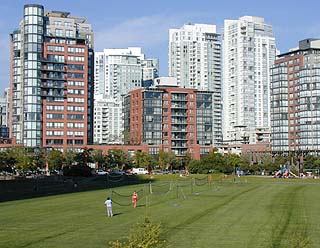
David Lum Park in Vancouver’s Roundhouse neighborhood. Abundant parks are part of the Vancouver style of urban development. |
So what exactly is the Vancouver style? Essentially, it is a neighborhood of “pin” or point towers, ranging from 15 to 40 stories, each separated by a minimum of 80 feet, but usually more in order to preserve public views and to maximize privacy. The towers have small floorplates — ideally 6,500 square feet — set on top of a podium that defines the streetscape. The podium has no blank walls: it’s lined with three-story townhouses or retail storefronts with commercial offices above. There is landscaping on top, parking underground.
The towers on are set in a grid of streets that extend the existing urban fabric, supplemented with separated bikeways and sidewalk boulevards. Double rows of trees line the streets, with landscaped setbacks and separate entrances for the townhouses.
It’s also a child-friendly neighborhood, with day-care and community centers. There are abundant parks and green spaces, along with public art and amenities. It’s a mixed-use neighborhood with a mixed-income population.
A little history
In some form or other, Vancouver has been building highrises since the 1950s. It had no choice. Surrounded by mountains and water, the city had built out most of its 44 square miles by mid-century. There was nowhere to go but up.
The results, however, were not always well-received. Planners rezoned decaying streetcar neighborhoods and the downtown core for highrise development in the 1950s; engineers attempted to thrust freeways into the heart of the city; developers blindly demolished the heritage of previous generations.
Public reaction was so negative that it overturned the political establishment, stopped the freeways and killed urban renewal for the next two decades.
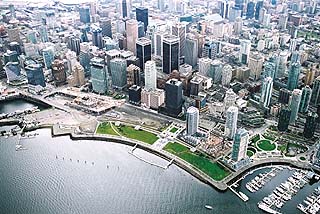
Photo courtesy of Vancouver Park Board
The Coal Harbour megaproject lies between Vancouver’s central business district and the waterfront. The project is converting an old railway and industrial area into a new inner city neighborhood.
|
Vancouver, in other words, turned into the San Francisco of the north, with very much the same results. The price of housing skyrocketed and housing shortages created political crises for City Hall.
By the late 1980s, attitudes changed. The tower was back, this time in the form of the condominium.
Now, City Hall had learned a thing or two. As the developer of the south shore of False Creek, the city learned how to build “complete communities” targeted to a mix of incomes and families with children. The pleasing results, along with the development of Granville Island, restored confidence. Yes, new development could actually improve the quality of life in the city.
The most important thing that didn’t happen was building freeways into the heart of the city. Without easy access to cheaper land in the suburbs, values remained high for residential housing, enough to justify the costs of concrete construction and underground parking.
Rethinking the core
By the 1990s, as demand for office space diminished, the city rethought its whole strategy for the core. Where there were once anonymous blocks of decaying warehouses, surface parking lots and vacated railway lands, now there were opportunities to build residential neighborhoods.
A new word was added to the Vancouver vocabulary: megaproject.
The best known is Concord Pacific Place — 204 acres expected to house about 15,000 people in 9,000 units. The Coal Harbour and Bayshore projects occupy a combined site of 60 acres, with an expected population of about 5,400 in 3,250 units. In addition, new neighborhoods are taking shape in the interior of the peninsula — Granville Slopes, Triangle West, Library Square, Yaletown, Downtown South — none of which existed prior to Expo ‘86.
Four lessons
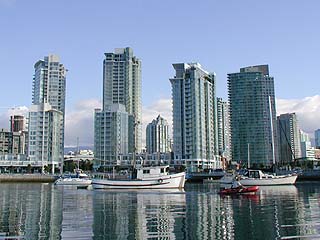
The pin towers of Concord Pacific Quayside are part of the Concord Pacific Place neighborhood. The 204-acre new neighborhood will one day house 15,000 people in 9,000 units.
|
First, this kind of inner-city, high-density community provides a way of living for many who only a few years ago could never have imagined living downtown, and who will, in doing so, keep the downtown alive.
Secondly, none of this development, save for the public housing, is subsidized. Growth is expected to help pay for growth. A long list of public benefits must be provided by the megaproject developer: waterfront walkways and roads, parks and marinas, school sites, child-care centers, community centers, and even public art. All this makes the developer’s product attractive. Public benefit, in short, adds private value.
Thirdly, this is not just a city for the rich. Specifically, 20 percent of all units on the megaprojects is reserved for social housing, and 25 percent is designed for families. Reductions in senior-government programs for non-market housing have delayed plans, but sites will be reserved for the time when funding becomes available.
Fourthly, in a generation the downtown peninsula will likely add another 50,000 people, doubling the downtown population. That constitutes just two or three years’ growth in the region. Still, it takes the pressure off stable neighborhoods, giving an option to newcomers who would otherwise compete for the existing housing stock with those who would be displaced.
Steps to livable density
Can other places make the same choices Vancouver did? Possibly, but they must do so in their own way. Portland, for instance, has chosen a medium-rise model of development in the Pearl District that works remarkably well.
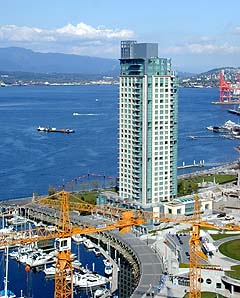
Anonymous blocks of warehouses, surface parking and railway land have been converted to residential neighborhoods.
|
Regardless of the particular form, however, there are some basics that are essential if the results are to be both humane and profitable.
- A community that makes clear its values and lays out the public benefits to be achieved. That is the reason for a plan, not just planning.
- Risk takers with vision. In other words, developers. Community groups may not always like them, but you can’t do without them.
- Risk takers with money. In other words, the bankers — who along with lawyers are often the designers by default of the public realm. You want ones who understand the longer term and the greater good, not just the mechanics of mortgage-backed securities and single-use zoning.
- Skilled professionals. The success of suburbia and the failure of public-housing projects led to the loss of a generation that could design, build and sell inner-city high-density accommodations. Those skills have to be relearned.
- A market. One can only build what others will pay for. My guess is there is a vastly underestimated market of people who wish to live in revitalized urban centers, with a premium on amenities and security.
It works for Vancouver; it may not work for all. But our experience suggests that the Vancouver style may for many cities be ready to wear.
Gordon Price was a city councillor in Vancouver from 1986 to 2003. He is now an adjunct professor in planning at the University of British Columbia.
Other Stories:
- Seattle calls on ‘Blue Ring’ plan for open space
- Parking lots designed to suck up storm water
- Seattle’s Green Streets ripe for modernization
- Urban sprawl causes waistline sprawl
- Sliver towers squeeze housing into downtown
- The surprising realities of apartment living
- WSU forges urban development partnership
- Living over the store in funky Fremont
- The evolving role of neighborhood retail
- Tight site parking problem? Stack those cars
- Eastside tries filling an affordable housing gap
- Tax increment financing: why it isn’t working here
- Reinventing the residential high-rise
Copyright ©2009 Seattle Daily Journal and DJC.COM.
Comments? Questions? Contact us.